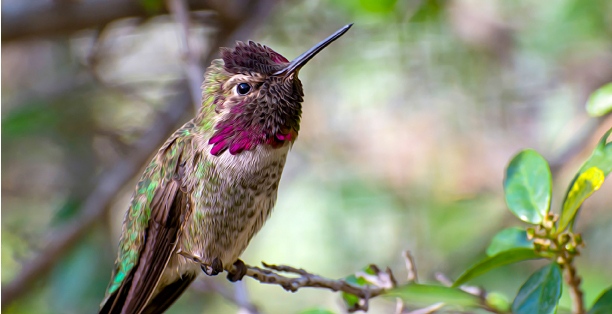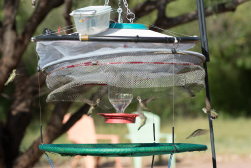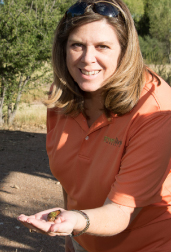
by Terri Sinclair
For the master bird bander, a bird in the hand is worth a wealth of knowledge about our ecosystems. Additionally, for members and visitors of the Southeastern Arizona Bird Observatory (SABO), hummingbird banding events provide the rare opportunity to have a hummingbird rest in your hand.
SABO was founded in 1995 by master bander Tom Wood and his wife Sheri Williamson. The couple moved to Arizona in 1988 to manage Ramsey Canyon Preserve, where a citizen scientist group was in the latter half of a hummingbird banding project. For Sheri, it didn’t take much convincing to continue the project. “It’s an obsession,” she said. “Hummingbirds are familiar and mysterious at the same time. There are still so many unanswered questions about how we can protect these birds for future generations.”
Visitors to SABO can be a part of that process by participating in hummingbird banding sessions.
Create a Hummingbird Habitat at Home
1. Plant flowers. Attract hummingbirds with hummingbird-pollinated native flowers that are part of the local ecosystem such as penstemon, chuparosa or fairy duster. In patio planters or in large gardens, plant it and they will come.
2. Avoid pesticides. Hummingbirds get most of their nutrition from the protein in small bugs like fruit flies and aphids.
3. Follow a healthy recipe. Red dye is unnecessary in hummingbird nectar and may be harmful to hummingbirds. Honey, agave or other sweeteners besides sugar may also be harmful. Add one part white granulated sugar to four parts water. Boil until sugar is dissolved, and let the mixture cool.
4. Keep fresh nectar in your feeder. Sugar water + heat = alcohol. In the summer, feeders should be cleaned and the fluid replaced daily; in the winter, every four to five days.
5. Offer nesting materials. Put out clean, pesticide-free pet hair — the lighter in color the better — to hide eggs from predators. Don’t offer dryer lint. This common tip can actually be dangerous to hummingbirds and their nestlings due to chemicals in the lint.
6. Leave out your ashes. The mineral content in ashes from untreated wood fires helps females replace nutrients they lose during egg production.
7. Encourage food sources. Add fruit scraps to your compost pile, or create a hanging compost where fruit flies can breed.
Banding and Observation Process
Volunteers set up a remote-controlled curtain trap around a known feeding spot. When a bird enters to feed, the curtain drops to enclose it. Trained, experienced handlers extract each bird gently to minimize stress.
Each bird is placed in a netted carrying bag until its turn for examination, which includes length of bill, wings and tail, weight, amount of fat, parasites, pollen, presence of eggs and plumage. If the bird already has a band, the number is noted in the log. Bandless birds are fitted with a numbered band.
A handler holds the bird at a feeder until it is finished drinking, and then the handler places the bird in the open palm of an attendee. The hand acts as a launch pad for the bird to go back into the wild. Most birds fly away quickly, but some will sit for several minutes.
A hummingbird’s breathing rate is around 250 breaths per minute at rest. As the lungs expand and contract with air, it produces a beat visitors can feel on the palm of their hand.
 Hummingbirds in Arizona
Hummingbirds in Arizona
Over 15 species of hummingbirds are full- or part-time Arizona residents. Many of the hummingbirds that use the flyway of the San Pedro River in Southeastern Arizona are migrating from nesting ground as far north as Alaska to winter habitats in Mexico. Williamson says, “Migratory birds are like the red blood cells in our bodies; they carry vital nutrients to the ecosystems they visit, bringing tropical resources to the temperate zone and vice versa.” Even small changes to these systems can have a big impact on everything living in that system, including humans.
If you want to be a resource for these birds, there are a few do’s and don’ts to keep in mind (see sidebar). Also remember, different species travel at different times of year, so keep up your good hummingbird habits year-round.
Attend a Banding Event
SABO holds hummingbird banding events every year between April and September. Events will be held each Saturday in September from 4-6 p.m. at the San Pedro House, seven miles east of Sierra Vista. The public is invited to attend and observe at no charge. Reservations are not required. Visit membershipandevents.sabo.org/Calendar.htm or call
520-432-1388 for more information.
Resources:
Hummingbird Plants – az.audubon.org/plants-attract-hummingbirds
Creating a Healthy Yard for Hummingbirds – az.audubon.org/healthy-yard
Hummingbird Citizen Science Program – hummingbirdsathome.org
Hummingbird Watching in Southeastern Arizona – sabo.org/hummers.htm
Kinds of Hummingbirds in Arizona – sabo.org/photoalb/hbsofaz.htm
Photos courtesy of Michael Moriarty





